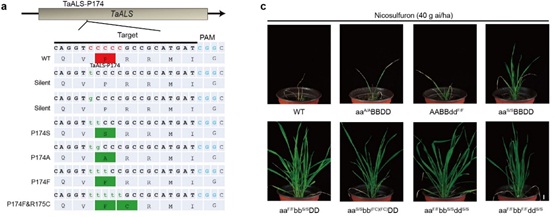Chinese farmers are facing worsening jointed goatgrass (Aegilops tauschii), a close relative to wheat, problems in their wheat field. Currently, mesosulfuron is the only wheat registered foliar-applied herbicide that provides control of jointed goatgrass in China but often damages the wheat. Non-transgenic wheat varieties tolerant to imidazolinone (IMI) herbicides can solve these problems. However, IMI herbicides persist in the soil and severely damage sensitive crops planted months and even years later. Therefore, non-transgenic crops with herbicide tolerance traits, coupled with low-risk herbicides, are badly needed by millions of multi-cropping farmers in their battle against weeds.
Recently, a research team led by Prof. GAO Caixia and LI Jiayang at Institute of Genetics and Developmental Biology of Chinese Academy of Sciences (IGDB, CAS) and
Associate Prof. JIANG Linjian at China Agricultural University (CAU), generated several herbicide tolerant wheat germplasms using base editing to facilitate weed control in wheat field.
The researchers generated wheat germplasms harboring herbicide tolerance mutations that confer tolerance to sulfonylurea-, imidazolinone- and aryloxyphenoxy propionate-type herbicides by base editing the acetolactate synthase (ALS) and acetyl-coenzyme A carboxylase genes of commercial wheat cultivar Kenong199. The mutations at wheat ALS P174 codon (TaALS-P174) endow tolerance to nicosulfuron, a sulfonylurea herbicide with a relatively low risk to subsequently planted crops, indicating great application value in the filed production. The mutations at both TaALS-P174 and TaALS-G631 positions conferred tolerance to imazapic, an IMI herbicide, at 3 times and even 5 times the field-recommended rate. The researchers also obtained quizalofop tolerant wheat editing TaACCase-A1992.
Moreover, they found that base editing at TaALS-P174 endowed wheat with sufficient resistance to nicosulfuron herbicide in MS growth medium to allow selection. When the TaALS-P174 editor was coupled with editors for other targets of interest, co-editing occurred in the nicosulfuron-resistant plants, and selection for resistance in growth medium enriched the frequency of coupled targets by several-fold.
As TaALS-P174 is conserved across plant species, similar selectable co-editing systems could be readily established to facilitate base editing in other plant species.
The paper entitled “Generation of herbicide tolerance traits and a new selectable marker in wheat using base editing” has been published online in Nature Plants on April 15th, 2019 (
DOI: 10.1038/s41477-019-0405-0), with ZHANG Rui and LIU Jinxing as the co-first authors. The work was conducted in collaboration with Prof. GAO Caixia and Li Jiayang at IGDB CAS and Associate Prof. JIANG Linjian at CAU.
The work was supported by by grants from the National Key Research and Development Program of China, the National Natural Science Foundation of China, the Chinese Academy of Sciences and Beijing Municipal Science and Technology.


Figure 2: Selectable co-editing systems


